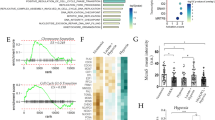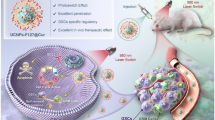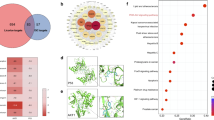Abstract
Apigenin, a natural flavonoid compound present in a variety of edible plants and health foods, has an anti-tumor effect and inhibits hypoxia inducible factor-lα (HIF-1α) expression in hypertrophic cardiac tissues. However, whether or not apigenin has a radiosensitization effect on glioma stem cells (GSCs) is unknown. Our present study aimed to investigate the effect of apigenin and its possible mechanisms. The human GSCs SU3 and its radioresistance line SU3-5R were treated with apigenin, radiation, or their combination, and the cell proliferation, migration, colony formation, and intracellular lactic acid and glycolytic related protein expressions were determined. Additionally, a cell model with hypoxia-induced HIF-1α expression was used and treated with apigenin. The current results displayed that the combination of apigenin and radiation could synergically reduce the viability, colony formation, and migration of the both GSCs. Moreover, this combination could also decrease the radiation-induced increments of glycolytic production lactic acid in the both GSCs and related protein expressions, including HIF-1α, glucose transporter (GLUT)-1/3, nuclear factor kappa B (NF-κB) p65, and pyruvate kinase isozyme type M2 (PKM2). Further study confirmed that after treatment of hypoxia-cultured SU3 or SU3-5R cells with apigenin, the expression levels of HIF-1α, GLUT-1/3, NF-κB p65, and PKM2 proteins were reduced. These results demonstrated that apigenin could increase the radiosensitivity of GSCs and its radiosensitization mechanisms were attributable to the attenuation of glycolysis, which might result from the inhibition of HIF-1α expression and subsequent reductions of GLUT-1/3, NF-κB, and PKM2 expressions.






Similar content being viewed by others
Data availability
The datasets used and/or analyzed during the current study are available from the corresponding author on reasonable request.
Code availability
Not applicable.
References
Reifenberger G, Wirsching HG, Knobbe-Thomsen CB, Weller M. Advances in the molecular genetics of gliomas—implications for classification and therapy. Nat Rev Clin Oncol. 2017;14:434–52.
Kumar S, Visvanathan A, Arivazhagan A, Santhosh V, Somasundaram K, Umpathy S. Assessment of radiation resistance and therapeutic targeting of cancer stem cells: a Raman spectroscopic study of glioblastoma. Anal Chem. 2018;90:12067–74.
Schulz A, Meyer F, Dubrovska A, Borgmann K. Cancer stem cells and radioresistance: DNA repair and beyond. Cancers. 2019;11:862.
Baik SH, Kang S, Lee W, Choi H, Chung S, Kim JI, et al. A breakdown in metabolic reprogramming causes microglia dysfunction in Alzheimer’s disease. Cell Metab. 2019;30:493–507.
Wang Y, Han X, Fu M, Wang J, Song Y, Liu Y, et al. Qiliqiangxin attenuates hypoxia-induced injury in primaryrat cardiac microvascular endothelial cells via promoting HIF-1α-dependent glycolysis. J Cell Mol Med. 2018;22:2791–803.
Miska J, Lee-Chang C, Rashidi A, Muroski ME, Chang AL, Lopez-Rosas A, et al. HIF-1α is a metabolic switch between glycolytic-driven migration and oxidative phosphorylation-driven immunosuppression of Tregs in glioblastoma. Cell Rep. 2019;27:226–37.
Jin P, Shin SH, Chun YS, Shin HW, Shin YJ, Lee Y, et al. Astrocyte-derived CCL20 reinforces HIF-1-mediated hypoxic responses in glioblastoma by stimulating the CCR6-NF-κB signaling pathway. Oncogene. 2018;37:3070–87.
Gabriely G, Wheeler MA, Takenaka MC, Quintana FJ. Role of AHR and HIF-1α in glioblastoma metabolism. Trends Endocrinol Metab. 2017;28:428–36.
Harada H, Inoue M, Itasaka S, Hirota K, Morinibu A, Shinomiya K, et al. Cancer cells that survive radiation therapy acquire HIF-1 activity and translocate toward tumour blood vessels. Nat Commun. 2012;3:783.
Nakashima R, Goto Y, Koyasu S, Kobayashi M, Morinibu A, Yoshimura M, et al. UCHL1-HIF-1 axis-mediated antioxidant property of cancer cells as a therapeutic target for radiosensitization. Sci Rep. 2017;7:6879.
Mossenta M, Busato D, Dal Bo M, Toffoli G. Glucose metabolism and oxidative stress in hepatocellular carcinoma: role and possible implications in novel therapeutic strategies. Cancers. 2020;12:1668.
Fu S, Li Z, Xiao L, Hu W, Zhang L, Xie B, et al. Glutamine synthetase promotes radiation resistance via facilitating nucleotide metabolism and subsequent DNA damage repair. Cell Rep. 2019;28:1136–43.
Bhatt AN, Chauhan A, Khanna S, Rai Y, Singh S, Soni R, et al. Transient elevation of glycolysis confers radio-resistance by facilitating DNA repair in cells. BMC Cancer. 2015;15:335.
Madunic J, Madunic IV, Gajski G, Popic J, Garaj-Vrhovac V. Apigenin: a dietary flavonoid with diverse anticancer properties. Cancer Lett. 2018;413:11–22.
Zhu ZY, Gao T, Huang Y, Xue J, Xie ML. Apigenin ameliorates hypertension-induced cardiac hypertrophy and down-regulates cardiac hypoxia inducible factor-l alpha in rats. Food Funct. 2016;7:1992–8.
Wang AD, Dai XL, Cui BQ, Fei XF, Chen YM, Zhang JS, et al. Experimental research of host macrophage canceration induced by glioma stem progenitor cells. Mol Med Rep. 2015;1:2435–42.
Shen YT, Chen H, Zhang JS, Chen YM, Wang MY, Ma JW, et al. Increased notch signaling enhances radioresistance of malignant stromal cells induced by glioma stem/progenitor cells. PLoS One. 2015. https://doi.org/10.1371/journal.pone.0142594.
Wang F, Fan K, Zhao Y, Xie ML. Apigenin attenuates TGF-β1-stimulated cardiac fibroblast differentiation and extracellular matrix production by targeting miR-155-5p/c-Ski/Smad pathway. J Ethnopharmacol. 2021;265:113195.
Zhou YY, Wang HY, Tang ZG, Ma DL. Two new formulae for evaluating effectiveness of drug combinations and revision of Bürgi’s and Jin’s modified Bürgi’s formula. Acta Pharmacol Sin. 1984;5:217–21.
Wang F, Zhao Y, Fan K, Xie ML. Apigenin suppresses TGF-β1-induced cardiac fibroblast differentiation and collagen synthesis through the downregulation of HIF-1α expression by miR-122–5p. Phytomedicine. 2021;83:153481.
Bouchart C, Trepant AL, Hein M, Van Gestel D, Demetter P. Prognostic impact of glioblastoma stem cell markers OLIG2 and CCND2. Cancer Med. 2020;9:1069–78.
Jagust P, de Luxan-Delgado B, Parejo-Alonso B, Sancho P. Metabolism-based therapeutic strategies targeting cancer stem cells. Front Pharmacol. 2019;10:203.
Shen H, Hau E, Joshi S, Dilda PJ, McDonald KL. Sensitization of glioblastoma cells to irradiation by modulating the glucose metabolism. Mol Cancer Ther. 2015;14:1794–804.
Hirschhaeuser F, Sattler UGA, Mueller-Klieser W. Lactate: a metabolic key player in cancer. Cancer Res. 2011;71:6921–5.
Nagao A, Kobayashi M, Koyasu S, Chow CCT, Harada H. HIF-1-dependent reprogramming of glucose metabolic pathway of cancer cells and its therapeutic significance. Int J Mol Sci. 2019;20:238.
Zhang T, Niu XH, Liao LL, Cho EA, Yang HF. The contributions of HIF-target genes to tumor growth in RCC. PLoS One. 2013;8:e80544.
Yang C, Zhong ZF, Wang SP, Vong CT, Yu B, Wang YT. HIF-1: structure, biology and natural modulators. Chin J Nat Med. 2021;19:521–7.
Galeaz C, Totis C, Bisio A. Radiation resistance: a matter of transcription factors. Front Oncol. 2021;11:662840.
Acknowledgements
This work was supported by the Science & Technology Project of Suzhou City for Medical Health (KJXW2020039).
Funding
This study was supported by the Science & Technology Project of Suzhou City for Medical Health (KJXW2020039), China.
Author information
Authors and Affiliations
Contributions
YZ and HH performed the cell culture, pharmacodynamic study, and Western blot analysis. YZ wrote the first draft of the manuscript. HH and C-HJ collected and analyzed the experimental data. KF performed the measurements of biochemistry indexes. TX, Z-YZ, and M-LX designed the study and reviewed the manuscript. All authors approved the final manuscript.
Corresponding authors
Ethics declarations
Conflict of interest
None.
Ethical approval
Not applicable.
Consent to participate
Not applicable.
Consent for publication
Not applicable.
Additional information
Publisher's Note
Springer Nature remains neutral with regard to jurisdictional claims in published maps and institutional affiliations.
Supplementary Information
Below is the link to the electronic supplementary material.
Rights and permissions
About this article
Cite this article
Zhao, Y., Huang, H., Jia, CH. et al. Apigenin increases radiosensitivity of glioma stem cells by attenuating HIF-1α-mediated glycolysis. Med Oncol 38, 131 (2021). https://doi.org/10.1007/s12032-021-01586-8
Received:
Accepted:
Published:
DOI: https://doi.org/10.1007/s12032-021-01586-8




